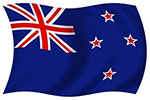 |
 |
 |
 |
PLEASE! If you see any mistakes, I'm 100% sure that I have wrongly identified some birds.
So please let me know on my guestbook at the bottom of the page
So please let me know on my guestbook at the bottom of the page
 The New Zealand Bellbird (Anthornis melanura), also known by its Māori names korimako and makomako, is a passerine bird endemic to New Zealand. It has greenish colouration and is the only living member of the genus Anthornis. The bellbird forms a significant component of the famed New Zealand dawn chorus of bird song that was much noted by early European settlers. The explorer Captain Cook wrote of its song "it seemed to be like small bells most exquisitely tuned". Its bell-like song is sometimes confused with that of the Tui. The species is common across much of New Zealand and its offshore islands as well as the Auckland Islands. Distribution The bellbird is found throughout both the main islands of New Zealand apart from the north of the North Island. Its population and distribution had been seriously affected by the introduction of European-style farming, which has led to the removal of native forests (the natural habitat of the bellbird). Another important factor is the introduction of predatory species such as cats, weasels, stoats, ferrets, rats and food-robbing species like wasps. Predators either eat the birds or consume eggs, while food robbers compete with the bellbird for its natural food sources of nectar, honeydew and insects. The decline occurred around the same time as many other New Zealand species, but for unknown reasons was reversed and the species is still common across much of New Zealand.   Range map from www.oiseaux.net - Ornithological Portal Oiseaux.net
www.oiseaux.net is one of those MUST visit pages if you're in to bird watching. You can find just about everything there
Description Males are olive green with a dark purplish sheen on their head and black outer wing and tail. While females are a duller olive brown with a blue sheen on the head and yellowish-white curving from the base of the bill to below the eye. Both have a notably red eye. They are about 17–20 cm from the tip of their beak to the end of their tail. Females weigh about 25 g and males 32 g. Juvenile females have brown eyes and a light yellow cheek stripe. Juvenile males have dull brown-black outer wing and tail feathers. Classification There are four sub-species: A. melanura melanura, A. melanura dumerii, A. melanura oneho, and A. melanura obscura. The Chatham bellbird, A. melanocephala, which became extinct in the early 20th century, was formerly classified as a subspecies of the New Zealand bellbird, as A. melanura melanocephala. Behaviour Breeding Breeding occurs from September to January where two broods can be produced. Their nesting habits are similar to the Tui in respect to colour of eggs, clutch size and incubation. They generally lay three to four eggs with pinkish brown spots and blotches. Diet Bellbirds feed on nectar, fruit and insects. Insects are important for females and their chicks during the breeding season. As honeyeaters they play an important part pollinating numerous native plants such as mistletoe, fuchsia and kowhai. Songs Bellbird song consists of three distinct sounds similar to the sound of chiming bells. They sing during the day but more in the early morning and late evening. Their alarm call is a repeated set of harsh staccato notes, similar to a blackbird. Listen to the New Zealand Bellbird
Sound from www.xeno-canto.org
 Conservation status
 Least concern (IUCN 3.1)
IUCN Red List of Threatened Species. Version 2013.2. International Union for Conservation of Nature. Retrieved 26 November 2013.
From Wikipedia, the free encyclopedia
  Sighted: 24 October 2017 (Date of first photo that I could use) Location: Tawharanui Regional Park  New Zealand Bellbird - Anthornis melanura - Tawharanui Regional Park - 24 October 2017
 New Zealand Bellbird - Tiritiri Matangi Island - Tawharanui Regional Park - 25 October 2017
 New Zealand Bellbird - Tiritiri Matangi Island - Tawharanui Regional Park - 25 October 2017
 Going bird watching on New Zealand? I have been to a few places but so far New Zealand is outstanding regarding information on the internet. There are two organizations that are sticking  out so far when it comes to information about birds and wildlife/ outdoor living. out so far when it comes to information about birds and wildlife/ outdoor living.
Bird information, bird song and maps. Yes, there are excellent trekking maps online so you can plan, or go back after the trek to see where you have been, excellent. I have not been disappointed. • New Zealand Birds Online nzbirdsonline.org.nz • New Zealand's Department of Conservation www.doc.govt.nz Click on “Nature” or just hoover with the mouse over the “Nature” Many other places I have been to have excellent maps on site, but trying to find them online  rendering nothing but disappointments. The New Zealand's Department of Conservation is the ONE STOP ONLY for everything regarding outdoor activities on New Zealand. rendering nothing but disappointments. The New Zealand's Department of Conservation is the ONE STOP ONLY for everything regarding outdoor activities on New Zealand.
New Zealand Birds Online, there is everything you ever wish to know about the birds on New Zealand. Nothing less than fantastic. Click HERE to down load Checklist of the birds of NZ from New Zealand Birds Online web page nzbirdsonline.org.nz One of the best web pages I have ever seen when it comes to birding. All the information you can ever ask for and a ONE STOP for all your needs before going bird watching on New Zealand. Range maps, sounds, information and bird lists, everything you need.   PLEASE! If I have made any mistakes identifying any bird, PLEASE let me know on my guestbook  You are visitor no.
To www.aladdin.st since December 2005
|
 |